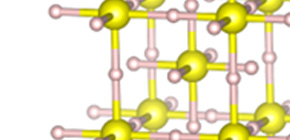
Crystal structures of superconductors at -70 degrees C clarified, a world first
A big step toward the realization of room-temperature superconductors
A group of researchers led by Specially Appointed Assistant Professor EINAGA Mari, Specially Appointed Lecturer SAKATA Masafumi, and Professor SHIMIZU Katsuya at the Center for Science and Technology Under Extreme Conditions, Graduate School of Engineering Science, Osaka University, Dr. Mikhail Eremets at the Max-Planck Institut für Chemie, Germany, and Senior Scientist OHISHI Yasuo at the Japan Synchrotron Radiation Research Institute clarified the crystal structure of the superconductivity phase of hydrogen sulfide at the high-temperature of 203 degrees K (minus 70 degrees Celsius), which emerged at a pressure of 150GPa, by means of synchrotron X-ray diffraction measurements combined with electrical resistance measurements in a high pressure device, a diamond anvil cell, at the large-scale synchrotron radiation facility SPring-8.
Conductors lose electrical resistance at very low temperatures. If superconductors are used for power lines, it becomes possible to carry electricity without a loss of energy, which will solve energy problems. Superconductivity is a very important physical phenomenon and is used for magnetic resonance imaging (MRI). However, the superconducting transition temperature is very low, so it costs a lot to cool materials down to that temperature, which prevents practical use.
Last year, hydrogen sulfide set a new record for highest superconducting transition temperature under high pressure, which drew a lot of attention; however, its crystal structure, important information for clarifying the mechanism behind the superconductivity, was not understood.
This group performed measurements of X-ray diffraction and electric resistance at high pressures simultaneously, clarifying the crystal structures of the superconductivity phase of hydrogen sulfide at high-temperatures, a world first. Hydrogen sulfide is made up of light elements and the diameter of the sample is 30μm or less because of ultrahigh pressure generation, so it’s impossible to measure by an ordinary X-ray generator in a laboratory.
Therefore, this group conducted measurements at high pressure research beamline BL10XU at the large-scale synchrotron radiation facility SPring-8. X-rays of the order of micrometer diameters with high power and high energy can be used at BL10XU. This group conducted X-ray diffraction experiments and measured electric resistance at high pressure and low temperatures in order to examine the crystal structures of the superconductivity phase at high-temperatures. This group also clarified that hydrogen sulfide molecules H 2 S decomposed to H 3 S under high pressure and that this H 3 S presented superconductivity, a world first.
Furthermore, from changes in pressure of superconducting transition temperature measured simultaneously, it was found that there were two structures in superconductivity: hexagonal crystal H 3 S and cubical crystal H 3 S, both of which had been predicted from theoretical calculations. This group’s achievement will clarify the mechanism behind the high superconducting transition temperature observed in hydrogen sulfide as well as greatly contribute to the development of practical room-temperature superconductors.
Abstract
A superconducting critical temperature above 200 K has recently been discovered in H 2 S (or D 2 S) under high hydrostatic pressure. These measurements were interpreted in terms of a decomposition of these materials into elemental sulfur and a hydrogen-rich hydride that is responsible for the superconductivity, although direct experimental evidence for this mechanism has so far been lacking. Here we report the crystal structure of the superconducting phase of hydrogen sulfide (and deuterium sulfide) in the normal and superconducting states obtained by means of synchrotron X-ray diffraction measurements, combined with electrical resistance measurements at both room and low temperatures. We find that the superconducting phase is mostly in good agreement with the theoretically predicted body-centred cubic (bcc) structure for H 3 S. The presence of elemental sulfur is also manifest in the X-ray diffraction patterns, thus proving the decomposition mechanism of H 2 S to H 3 S + S under pressure.

To learn more about this research, please view the full research report entitled “ Crystal Structure of the Superconducting Phase of Sulfur Hydride ” at this page of the Nature Physics website.
Related links
